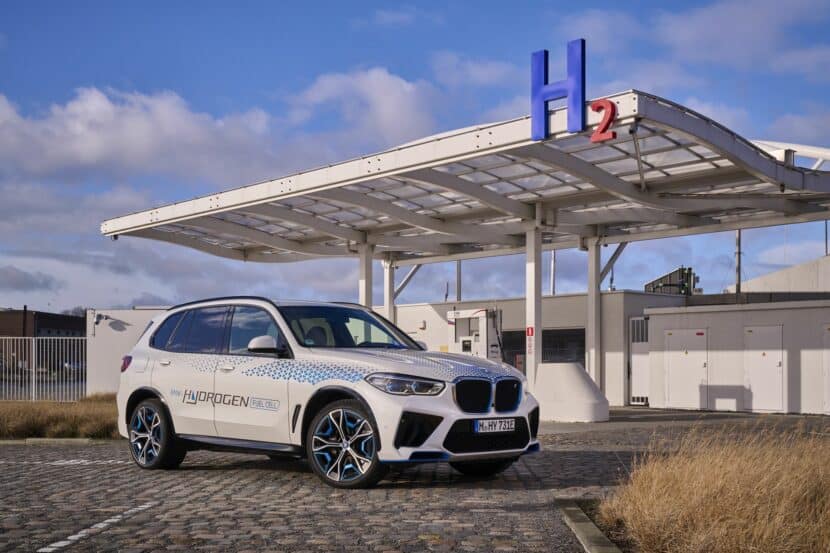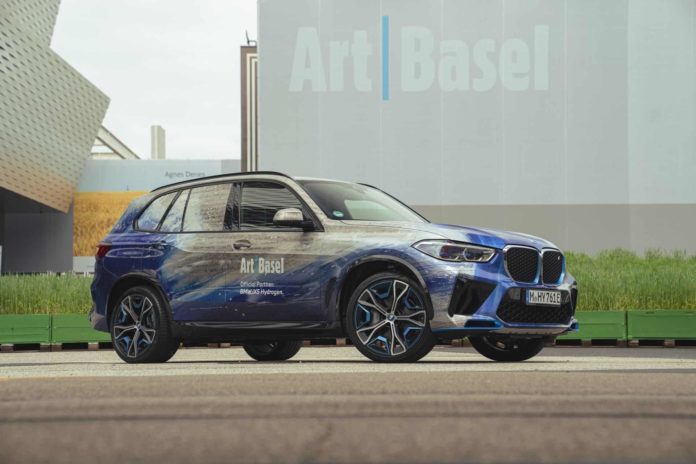At the 2024 Art Basel, BMW made a striking impression by unveiling a uniquely artistic color scheme for the iX5 Hydrogen. The new design, created by renowned artist Es Devlin, stood out brilliantly amidst the vibrant and creative crowd. The intricate exterior, featuring Devlin’s distinctive collage painting, captured the essence of both technological innovation and artistic expression, making the iX5 Hydrogen a centerpiece in an event filled with art enthusiasts. Thirty of these hydrogen-powered vehicles were used to shuttle VIPs around Basel, showcasing the practicality and efficiency of hydrogen as a fuel source.
The Inspiration Behind The Wrap

This unique wrap featured inspirations from Devlin’s childhood, including Katsushika Hokusai’s 1831 woodcut “The Great Wave off Kanagawa” and handwritten extracts from James Joyce’s “Ulysses”. The wrap also showcases the entire press release of the project, complemented by Joyce’s handwritten extracts.


According to Thomas Girst, Global Head of Cultural Engagement at BMW Group, the company has been eager to collaborate with Es Devlin since 2017. However, the ideal opportunity for such a partnership had not materialized until now. Both parties were waiting to find the perfect overlap of their creative and technological inquiries.
“Surfacing”


This project, encompassing sound, music, and light, was inspired by Devlin’s interactions with BMW’s engineers and their work on hydrogen technology. Her installation at Art Basel, “Surfacing”, begins with a line of light through water, reminiscent of her first memory, and continues to explore the fluid boundaries of walls of water. Devlin is renowned for her set design work on Beyoncé’s stadium tours Renaissance (2023) and Formation (2016), Lady Gaga’s Monster Ball (2009) and Miley Cyrus’s 2014 Bangerz tour.


Devlin’s newest creation was developed in collaboration with choreographer Sharon Eyal and commissioned by BMW. Initially, it appears as an ordinary art exhibit, but then the wall opens up, exposing a concealed area featuring a flowing water box. The installation astonishes the audience with its clever use of dual light lines, conjuring the illusion of five dancers materializing and disappearing as they execute their routines.
The artist says she’s been fascinated by the hydrogen fuel cell technology that powers the car, enabling it to intake oxygen while in motion and combine it with hydrogen to generate energy. This method not only produces energy but also emits water as a byproduct. Devlin finds a compelling parallel between her stage design work and this project. She frequently uses models and miniatures, captivated by the interplay between humans and automobiles.
BMW’s Hydrogen Efforts


Michael Rath, Head of Hydrogen Vehicles at BMW, also emphasized the importance of hydrogen for BMW Group, as an alternative to the multiple drivetrain choices offered in Munich. He points out that hydrogen technology is particularly suitable for long distance traveling with large vehicles like the BMW X5. Rath also sees the future of hydrogen also tied to the transportation and maritime industries which can accelerate the adoption of fuel cell vehicles.


Of course, there are plenty of hurdles on the way and one of them is a big one: the infrastructure. While countries like the United States don’t excel when it comes to hydrogen stations, in Germany, the infrastructure for hydrogen is robust, with three hydrogen stations in Munich alone. Commercial vehicles can already refuel at 350 bar at various hydrogen stations across the country.
This strong foundation supports the global deployment of the iX5 Hydrogen fleet, which has already been driven over one million kilometers across more than 20 countries. Hydrogen technology is also gaining traction in Japan and South Korea, where it is seen as a key component of future mobility.
First Production Series Hydrogen-Powered BMW By 2030


Looking ahead, BMW plans to introduce its first production series hydrogen vehicle before 2030. “We are seriously investigating a production series vehicle by the end of this decade,” Rath tells us. “What we are working right now is the density of the H2 compartment to bring as much H2 as possible inside the car, and also to improve the power output of the fuel cells and the entire drivetrain system,” Rath adds. While the company has not disclosed specific models, we believe that a Neue Klasse-based car could be among future FCEV offerings. This initiative underscores BMW’s commitment to exploring alternative energy sources, regardless of the architecture.
Rath also mentions that although the X5 is ideal for this pilot and larger cars in general, he doesn’t rule out the possibility of offering hydrogen-powered smaller BMWs in the future.
On May 21, 2024, the Council of the EU adopted the Hydrogen and Decarbonized Gas Market Package. This significant legislative measure aims to transition the gas system to low-carbon and renewable gases, and it includes a much-anticipated framework for dedicated hydrogen networks. By 2030, publicly accessible hydrogen refueling stations need to be deployed along the Trans-European Network – Transport.
Rath also tells us that two weeks ago, he received new from the European Commission that BMW can apply for subsidies. The EU granted, initially, €720 million for subsidizing renewable hydrogen production projects.
This project has been thrilling for both BMW Group and Es Devlin, taking everyone by surprise in Basel. Rath assures that the hydrogen initiatives will continue, with more intriguing projects on the horizon.

